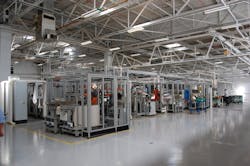Meritor seeks “strategic transformation” of its global foundation brake mindset
CWMBRAN, SOUTH WALES. The future of foundation brakes for commercial trucks and trailers can be boiled down into three fundamental concepts, according to Dietrich Zaps, Meritor’s GM for heavy vehicle braking systems in Europe: better quality, lower cost, and above all improved safety.
And suppliers that can deliver on all three of them – whether for “old school” drum brakes still favored across much of the world or for air disc brake (ADB) models that make up 82% of the brake market in Europe – will gain a competitive advantage in the global commercial vehicle marketplace.
“This is part of a long-term strategic concept we’ve begun to put in place over the last four years; a transformation of the mindset in how we approach our product line,” Zaps explained during a press tour here of Meritor’s Cwmbran [pronounced ‘Koom-brahn’] foundation brake manufacturing facility located in South Wales, U.K.
He noted that significant investments by Meritor in its braking business over the last several years – including an ongoing overhaul of its Cwmbran plant and $6 million to $7 million over three years for both in-house and fleet brake testing efforts – are all aimed at creating a more efficient brake product line.
“Such a transformation effort is not always visible but in the long run it works,” Zaps stressed.
The reason Meritor is so focused on “transforming” how it approaches the global commercial vehicle braking business rests in no small part on the dollar value of the “total addressable market” or TAM in three key areas of the world. The company estimates that TAM for North America in 2012 rested at $1 billion, with Europe at $1.2 billion and the Asia-Pacific region (driven largely by China and India) at $1.1 billion.
Gwyn Gardiner, Meritor’s Cwmbran plant site manager, noted that from a factory perspective the focus is on how to boost quality while driving down costs for both drum and ADB models alike.
For example, he said the ongoing overhaul of the Cwmbran plant should shrink its size from 520,000 total square feet down to 300,000 over the next several years, even as it doubles production capacity from its current 600,000 brake units per year to 1.2 million annually by 2016.
No part of the plant’s cost saving potential is overlooked, either, Gardiner added. The addition of more natural lighting, for one, reduced electricity demand and thus cut energy costs, while a similar effort to cut the plant’s fleet of forklifts [which are called ‘fork trucks’ in the U.K.] from 42 to nine by 2014 will also save on operational cost, too.
“Lean manufacturing concepts are standard business practices now and those concepts help us reduce the eventual cost of our brake products to the customer,” Chad Mitts, Meritor’s GM for its North American Brake division, told Fleet Owner.
“Shrinking the forklift fleet, for example, reducing our handling and indirect operating costs, while reducing plant size means less machinery and capital is needed to build our products,” he noted. “The two motivators for us going forward are improved quality and cost reduction – that will help us retain our competitiveness in all our markets.”
Each piece of the brake itself – be it drum or ADB – is also being continually examined from a cost and quality perspective. For example, Tony Williams, deputy head of sales for Meritor’s European brake operations, pointed out that the company has managed to reduce the weight of its current ADB design by 10% – leading to a 10% reduction in manufacturing costs.
“Any time you talk trucks, weight is an important factor, so any savings we can generate without compromising safety benefits the customer,” he said – adding that the 80% part commonality between all five of Meritor’s current ADB models helps reduce cost for the company and customer as well.
Reducing cost also allows for the redirection of capital to new product development, too, added Brian Harrison, Meritor’s business development manager for the European market. As an example, he pointed to two new ADB models Meritor is currently working on – the ELSA 195S and 175S – that are aimed at the medium and light-duty commercial vehicle segment.
Though there is no “time scale” for the introduction of those two new ADB models, he said they are in development to address a trend that Meritor expects to become stronger over the next three to five years: lighter class trucks, such as Class 6 models, being given duties reserved in the past for their heavier and more costly Class 8 brethren.
“You need more powerful brakes to handle such work demand,” added Zaps.
About the Author
Sean Kilcarr
Editor in Chief
Sean Kilcarr is a former longtime FleetOwner senior editor who wrote for the publication from 2000 to 2018. He served as editor-in-chief from 2017 to 2018.
